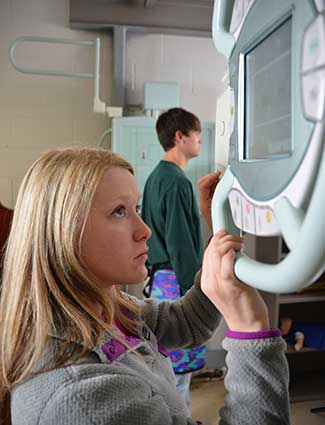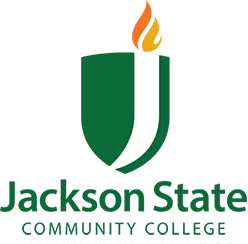Profession
Radiology is the medical specialty involving the use of radiant energy (x-rays, gamma rays, ultrasound, magnetic fields, radio frequencies, radioisotopes and other imaging modalities) to produce images helpful in diagnosis and treatment of disease.
Radiologic Technology as a profession was born early in the 1900's following the discovery of x-rays by Wilhelm C. Roentgen in 1895. Immediately it was apparent the new x-rays could be used to examine the human body, and the discovery proved to be of immeasurable value to medical science. Subsequent rapid development of technology and advances in application of the technologies has distinguished radiology as a highly skilled specialty in medicine.
The explosive growth of technology and knowledge in radiology has created an increasing need for competent radiologic technologists to assist physicians in the beneficial use of imaging technology for diagnosis and treatment of a wide variety of disorders. Jackson State’s Radiologic Technology program offers the opportunity for students to gain the knowledge and skills necessary to perform entry-level, medical radiography or diagnostic x-ray technology.

When students have completed the basic requirements to become registered radiographers, they have a marketable skill in the ability to produce diagnostic images utilizing conventional x-ray technology, and many avenues for further education and advancement are opened. Although most qualified technologists are employed as radiographers in hospitals, there is a demand for personnel in many related imaging areas which commonly require radiography education as a prerequisite to entering these fields. Some examples of imaging technologies related to radiography include diagnostic medical sonography (ultrasound), nuclear medicine technology, radiation therapy technology, computed tomography (CT scan), magnetic resonance imaging (MRI), mammography, cardiovascular interventional technology, and radiologist assistant (RA). At this time Jackson State Community College does not offer certificates or degrees in other imaging modalities, however, graduates successfully transfer to such programs in Memphis, Nashville, and Chattanooga, TN, and Paducah, KY.
Program
The Radiologic Technology Program at Jackson State began in 1969 as one of the first college based associate degree radiologic technology programs in Tennessee, and one of the very first Health Sciences programs established at the college. The JSCC Radiologic Technology program consistently produces competent graduates who are successful on the national certification examination and in the profession. While the vast majority of radiographers and medical imaging professionals in the JSCC service area are Jackson State graduates, several opt to travel outside the area and to other states for employment . The program maintains high standards and has a reputation for excellence in the medical imaging community.
Our programmatic accreditation agency, the Joint Review Committee on Education in Radiologic Technology (JRCERT), defines and publishes this information. Click here to go directly to the JRCERT webpage.
The Radiologic Technology Program sponsored by Jackson State Community College combines the basic sciences, general education, and professional courses with extensive clinical education performed at area hospitals.
Important Facts Concerning RADT Program Structure:
- College classes are offered on the main college campus during daytime hours (no evening or weekend classes available). While some virtual classes and hybrid models have been allowed during the pandemic, this will not be the new normal for the majority of courses.
- If a student accepted into the program has completed most, or all of the general education classes required as part of the RADT degree, it will NOT shorten the time necessary to complete the program. However, it can result in students registering for fewer credit hours each term and lighten their course load.
- Clinical rotations occur during mostly day hours (ranging from 5:30am - 9:30pm). There will be minimal weekend rotations during the third semester (first summer) term (4 Saturday and 4 Sunday rotations). Clinical rotations are scheduled in 8-hour shifts unless rotating away from home-base facility, those are 6-hour shifts.
- When students are selected into the program they are assigned a home-base clinical facility. This is determined by the students' indicated preference on their application and program officials try to accomodate those preferences when possible. However, there will be rotations to at least one other clinical facility for 5 weeks in the second fall term and for 4 weeks in the second spring term. Students will not rotate to all approved clinical locations affiliated with the RADT program, but all students will experience the differences between large and small bed facilities. Clinical sites are dispersed across a wide geographic location and drive times may be long. Students are responsible for dependable transportation to both the college campus and clinical locations and any costs associated with that travel.
- In order to participate in clinical education, students must meet the requirements of hospitals. This could include, but not limited to, background checks, drug screens, immunizations, TB skin test, etc. If a student is not fully compliant with these requirements, it may prohibit specific rotations in a clinical location and this could result in a student being unable to complete the program.
Accreditation
The Radiologic Technology Program is accredited by the:
Joint Review Committee on Education in Radiologic Technology20 N Wacker Dr., Suite 2850
Chicago, IL 60606-3182
Phone: (312) 704-5300
email: mail@jrcert.org
Program status is: Maintenance Accreditation for 8 years
Next accreditation report: April 1, 2023
The JRCERT is the only agency recognized by the United States Department of Education(USDE) and the Council for Higher Education Accreditation (CHEA), for the accreditation of traditional and distance delivery educational programs in radiography, radiation therapy, magnetic resonance, and medical dosimetry.
Mission Statement
Jackson State Community College Radiologic Technology Program provides the opportunity for students to develop the clinical skills and technical competencies required of a certified Radiographer at entry level combined with the necessary academic background to enable the graduate to advance within the profession. The Program maintains high educational standards evidenced through national programmatic accreditation and other benchmarks.
Radiologic Technology Program Goals & Outcomes
The program's mission is supported by the achievement of the following goals & outcomes:
Goal 1: Students will competently perform diagnostic radiologic technology procedures.
Learning Outcomes:
1.1 Students will accurately position patients for radiographic examinations.
1.2 Students will employ correct radiation protection practices.
Goal 2: Students will develop critical thinking skills applicable to radiologic technology.
Learning Outcomes:
2.1 Students will adapt radiographic procedures to non-routine situations.
2.2 Students will evaluate radiographic images for acceptable diagnostic quality.
Goal 3: Students will demonstrate effective communication skills.
Learning Outcomes:
3.1 Students will utilize acceptable verbal skills.
3.2 Students will display adequate communication skills in written works.
Goal 4 (Program Effectiveness): Graduates will contribute to the needs of the medical imaging community.
Outcomes:
4.1 Students will complete the program within the scheduled time frame.
4.2 Graduates will successfully complete the national certification examination.
4.3 Graduates will express satisfaction with their radiography education.
4.4 Graduates will accept positions in radiography and related modalities.
4.5 Employers will express satisfaction with graduates as entry-level radiographers.

